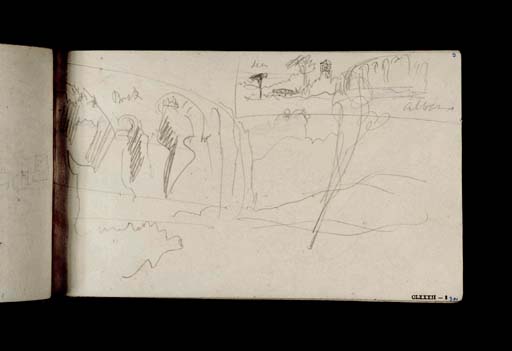Joseph Mallord William Turner The Amphitheatre of Domitian and the Church of San Paolo, Albano 1819
Image 1 of 2
Joseph Mallord William Turner,
The Amphitheatre of Domitian and the Church of San Paolo, Albano
1819
Joseph Mallord William Turner 1775–1851
Folio 3 Recto:
The Amphitheatre of Domitian and the Church of San Paolo, Albano 1819
D15300
Turner Bequest CLXXXII 3
Turner Bequest CLXXXII 3
Pencil on white wove paper, 113 x 189 mm
Inscribed by the artist in pencil ‘Brick’ within arched building top left and ‘Sea’ top centre and ‘Albano’ top right
Inscribed by John Ruskin in blue ink ‘3’ top right and ‘301’ bottom right
Stamped in black ‘CLXXXII 3’ bottom right
Inscribed by John Ruskin in blue ink ‘3’ top right and ‘301’ bottom right
Stamped in black ‘CLXXXII 3’ bottom right
Accepted by the nation as part of the Turner Bequest 1856
References
1909
A.J. Finberg, A Complete Inventory of the Drawings of the Turner Bequest, London 1909, vol.I, p.536, as ‘ “Albano” ’.
1979
Andrew Wilton, The Life and Work of J.M.W. Turner, Fribourg 1979, p.384 no.731.
1984
Cecilia Powell, ‘Turner on Classic Ground: His Visits to Central and Southern Italy and Related Paintings and Drawings’, unpublished Ph.D thesis, Courtauld Institute of Art, University of London 1984, pp.194 note 102, 421, as ‘Sketches of the Roman remains at Albano (one building labelled Brick’.
1987
Cecilia Powell, Turner in the South: Rome, Naples, Florence, New Haven and London 1987, p.[88] note 78.
2000
David Hill, Joseph Mallord William Turner: Le Mont-Blanc et la Vallée d’Aoste, exhibition catalogue, Museo Archeologico Regionale, Aosta / Musée Archéologique Régional, Aoste 2000, p.295.
The sketches on this page depict the ruins of the Amphitheatre of Domitian at Albano. There are many ancient remains to be seen in the town including the Castra Albana camp of Septimius Severus, the imperial villa, the ancient gates of the Porta Pretoria and Porta Principalis Sinistra, the baths of Cellomaio and the cistern which fed the town. However, Octavian Blewitt in his Hand-book for Travellers in Central Italy (first published in 1842) described the amphitheatre as ‘the most remarkable remains’ which were situated ‘between the Church of S. Paolo and the Cappuccini, mentioned by Suetonius and by Juvenal as the scene of the most revolting cruelties of the last and worst of the Caesars.’1 The smaller study in the top right-hand corner appears to depict part of the amphitheatre on the hill above the town with the campanile of the Church of San Paolo visible on the left (see also folio 1 verso, D15297). Turner’s sketch shows the ruins on the right and the sea on the left and confirms that he must have been facing south-west.
Turner’s rough sketches of these ruins may have been inspired by Piranesi (1720–1778). The latter’s etching Rovine dell’Anfiteatro detto di Domiziano was published as part of Antichità d’Albano e di Castel Gandolfo, 1764.2 The larger view in particular is similar in composition to Piranesi’s and captures something of the crumbling grandeur of the brick arches.
Nicola Moorby
May 2008
How to cite
Nicola Moorby, ‘The Amphitheatre of Domitian and the Church of San Paolo, Albano 1819 by Joseph Mallord William Turner’, catalogue entry, May 2008, in David Blayney Brown (ed.), J.M.W. Turner: Sketchbooks, Drawings and Watercolours, Tate Research Publication, December 2012, https://www


